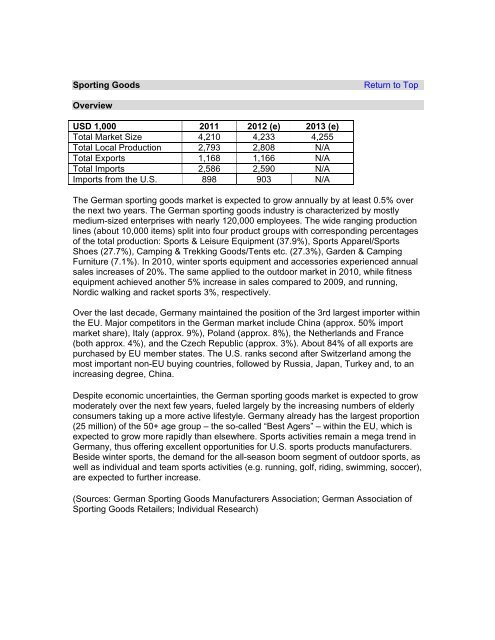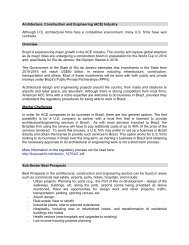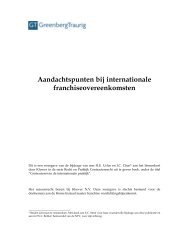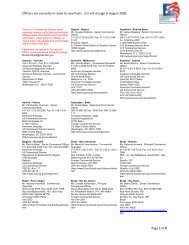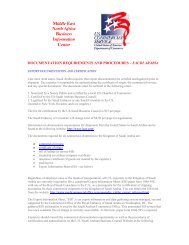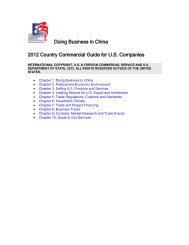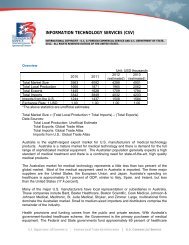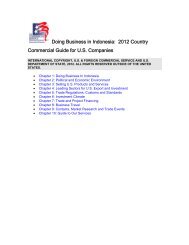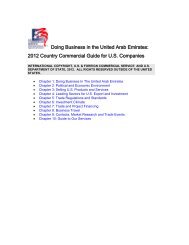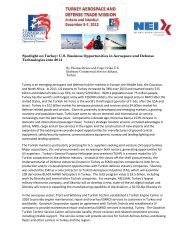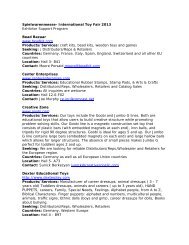Doing Business In Germany: A Country Commercial ... - Export.gov
Doing Business In Germany: A Country Commercial ... - Export.gov
Doing Business In Germany: A Country Commercial ... - Export.gov
You also want an ePaper? Increase the reach of your titles
YUMPU automatically turns print PDFs into web optimized ePapers that Google loves.
Sporting Goods Return to Top<br />
Overview<br />
USD 1,000 2011 2012 (e) 2013 (e)<br />
Total Market Size 4,210 4,233 4,255<br />
Total Local Production 2,793 2,808 N/A<br />
Total <strong>Export</strong>s 1,168 1,166 N/A<br />
Total Imports 2,586 2,590 N/A<br />
Imports from the U.S. 898 903 N/A<br />
The German sporting goods market is expected to grow annually by at least 0.5% over<br />
the next two years. The German sporting goods industry is characterized by mostly<br />
medium-sized enterprises with nearly 120,000 employees. The wide ranging production<br />
lines (about 10,000 items) split into four product groups with corresponding percentages<br />
of the total production: Sports & Leisure Equipment (37.9%), Sports Apparel/Sports<br />
Shoes (27.7%), Camping & Trekking Goods/Tents etc. (27.3%), Garden & Camping<br />
Furniture (7.1%). <strong>In</strong> 2010, winter sports equipment and accessories experienced annual<br />
sales increases of 20%. The same applied to the outdoor market in 2010, while fitness<br />
equipment achieved another 5% increase in sales compared to 2009, and running,<br />
Nordic walking and racket sports 3%, respectively.<br />
Over the last decade, <strong>Germany</strong> maintained the position of the 3rd largest importer within<br />
the EU. Major competitors in the German market include China (approx. 50% import<br />
market share), Italy (approx. 9%), Poland (approx. 8%), the Netherlands and France<br />
(both approx. 4%), and the Czech Republic (approx. 3%). About 84% of all exports are<br />
purchased by EU member states. The U.S. ranks second after Switzerland among the<br />
most important non-EU buying countries, followed by Russia, Japan, Turkey and, to an<br />
increasing degree, China.<br />
Despite economic uncertainties, the German sporting goods market is expected to grow<br />
moderately over the next few years, fueled largely by the increasing numbers of elderly<br />
consumers taking up a more active lifestyle. <strong>Germany</strong> already has the largest proportion<br />
(25 million) of the 50+ age group – the so-called “Best Agers” – within the EU, which is<br />
expected to grow more rapidly than elsewhere. Sports activities remain a mega trend in<br />
<strong>Germany</strong>, thus offering excellent opportunities for U.S. sports products manufacturers.<br />
Beside winter sports, the demand for the all-season boom segment of outdoor sports, as<br />
well as individual and team sports activities (e.g. running, golf, riding, swimming, soccer),<br />
are expected to further increase.<br />
(Sources: German Sporting Goods Manufacturers Association; German Association of<br />
Sporting Goods Retailers; <strong>In</strong>dividual Research)


